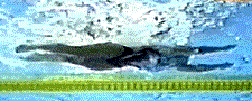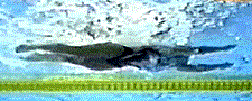HOW CHAMPIONS DO IT
Researched, produced, and prepared by Brent S. Rushall,
Ph.D., R.Psy.

AGNES KOVACS AT 170 m OF HER GOLD MEDAL 200 m BREASTSTROKE RACE AT THE 2001 WORLD CHAMPIONSHIPS IN FUKUOKA
Each frame is .1 seconds apart. Agnes Kovacs' time for this race was 2:24.90.
This stroke analysis includes a moving sequence in real time, a moving sequence where each frame is displayed for .5 of a second, and still frames.
The following image sequence is in real time. It will play through 10 times and then stop. To repeat the sequence, click the browser's "refresh" or "reload" button.

The following image sequence shows each frame for half a second. It will play through 10 times and then stop. To repeat the sequence, click the browser's "refresh" or "reload" button.

At the end of the following narrative, each frame is illustrated in detail in a sequential collage.
Notable Features
Frames #1 and #2 depict one of the unusual characteristics of Agnes Kovacs' stroke. She recovers her hands forward and well apart. Given traditional thinking, this is not as streamlined as when the hands are recovered forward together. However, at the end of her recovery, her hands finish in a position where she can immediately execute a "butterfly-type" pull. She does not have to perform an outward sculling action that starts from zero or a very low velocity. Since the outward sculling action that occurs after a traditional forward recovery develops little, if any propulsion, the cost of loss of streamline in Kovacs' recovery may be offset at least equally or to advantage by the lack of need to perform an outward sculling action. By not performing an outward scull, the swimmer can initiate a pull sooner as the "extra" movement of sculling does not occur.
Frames #3 through #7 demonstrate a powerful butterfly-type pull. The length of its propulsive impulse is much longer than that which occurs in a "traditional" breaststroke pull. This would seem to be a great advantage. Arm propulsion of this form should be very effective and an advancement over traditional styles.
Frames #8 through #10 illustrate a breath and hand redirection of a modern-traditional form.
Frames #11 through #16 demonstrate actions that most likely will detract from the advantages gained through Kovacs' innovative arm-propulsion. Frames #11 and #12 illustrate the kick being initiated in a desirable manner. The feet are fully turned out at the start of the kick (just after Frame #11), propulsion is developed with the full inner foot and lower leg. However, the arms dive forward and down causing a vertical force component. That force component needs to be counterbalanced by an action on the other side of the swimmer's center of buoyancy. What happens is illustrated in Frames #13 through #15. The kick is compromised by having to kick partly down instead of directly backward. Thus, some propulsive force from the kick is lost in the corrective action of developing a vertical force component. As well as the kick being directed slightly downward, at the end of the kick (Frame #15) the swimmer is out of streamline and an added repositioning movement has to occur (it is almost fully completed in Frame #16). This writer hypothesizes that the downward kick and alignment correction after the kick is completed, detracts from the benefits gained through not doing an outward scull in the pull and the greater effectiveness of the pull. The downward kick and reposition consume time that could have been used to get on with the next stroke. One is set to wonder how well Agnes Kovacs would perform if her recovery were directly forward and flat, much in the manner of that displayed by other top female swimmers such as Xuejuan Luo.
If Agnes Kovacs were to remove the problematical time-consuming and kick-force-reducing features of her stroke, her stroke rate would improve and there would be less slowing between the end of the kick and the start of the next pull. Those changes would improve her overall 200m swimming time but would be very noticeable in her 100 and 50m performances. Clearly, there is a hint of changes in Kovacs' breaststroke swimming that suggests how the stroke will be swum in the future. However, at present Agnes Kovacs' breaststroke is not the "complete package".

Return to Table of Contents for this section.






